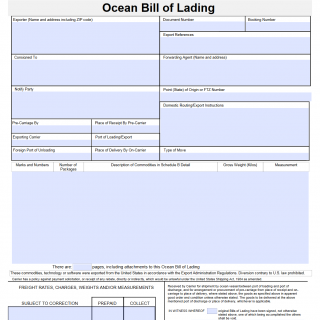Ocean Bill of Lading
An ocean bill of lading is a legal document that serves as a contract between a shipper and a carrier for the transportation of goods by sea. It serves as both a receipt for the goods being shipped and a document of title that can be used to transfer ownership of the goods.
The parts of an ocean bill of lading typically include:
- Shipper information: This includes the name, address, and contact information of the party shipping the goods.
- Consignee information: This includes the name, address, and contact information of the party receiving the goods.
- Carrier information: This includes the name, address, and contact information of the carrier responsible for transporting the goods.
- Description of goods: This section provides a detailed description of the goods being shipped, including any relevant specifications, quantities, and packaging information.
- Shipping instructions: This section provides instructions for the carrier regarding the transport and delivery of the goods.
- Freight charges: This section outlines the charges associated with shipping the goods, including any applicable fees or surcharges.
- Date of shipment and expected delivery date: This section specifies the date the goods were shipped and the expected delivery date.
An ocean bill of lading is typically drawn up in cases where goods are being transported by sea, such as in international trade. The parties involved in an ocean bill of lading are the shipper, who is responsible for sending the goods, the carrier, who is responsible for transporting the goods, and the consignee, who is responsible for receiving the goods.
When compiling an ocean bill of lading, it is important to ensure that all of the relevant details are included, such as the correct description and quantity of goods being shipped, as well as the correct shipping instructions and freight charges. It is also important to ensure that the document is signed and dated by all parties involved.
The advantages of an ocean bill of lading include providing a clear and formal record of the shipment of goods, as well as establishing a clear understanding of the responsibilities and obligations of the shipper, carrier, and consignee. However, if an ocean bill of lading is filled out incorrectly, it may lead to misunderstandings or disputes between the parties involved, which can result in delays, additional costs, or loss of goods. Therefore, it is important to carefully review and double-check the information included in an ocean bill of lading before submitting it for transport.

